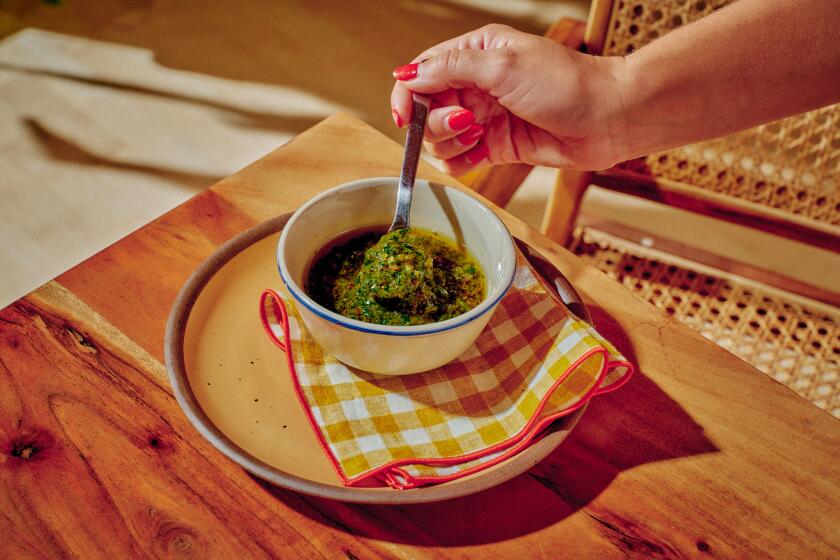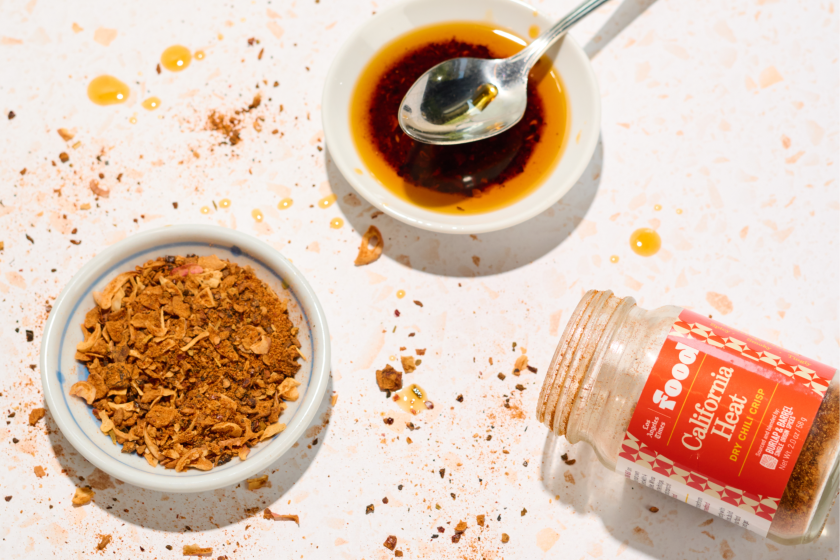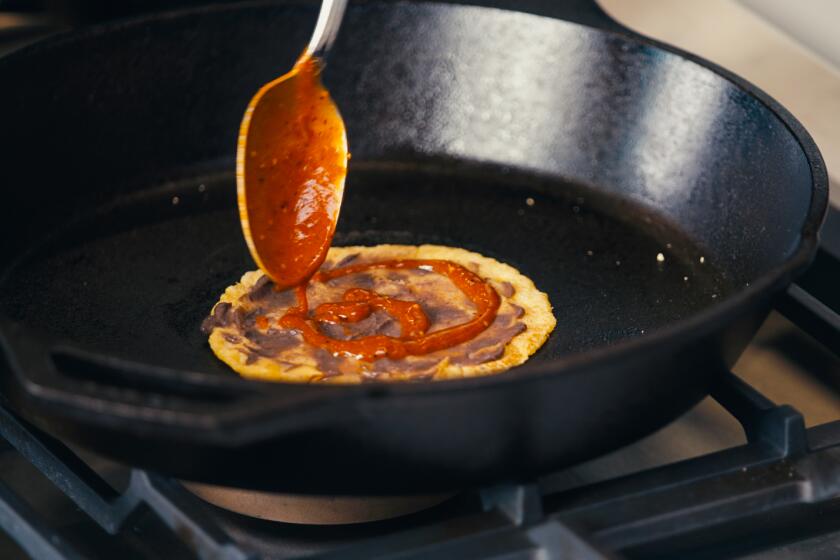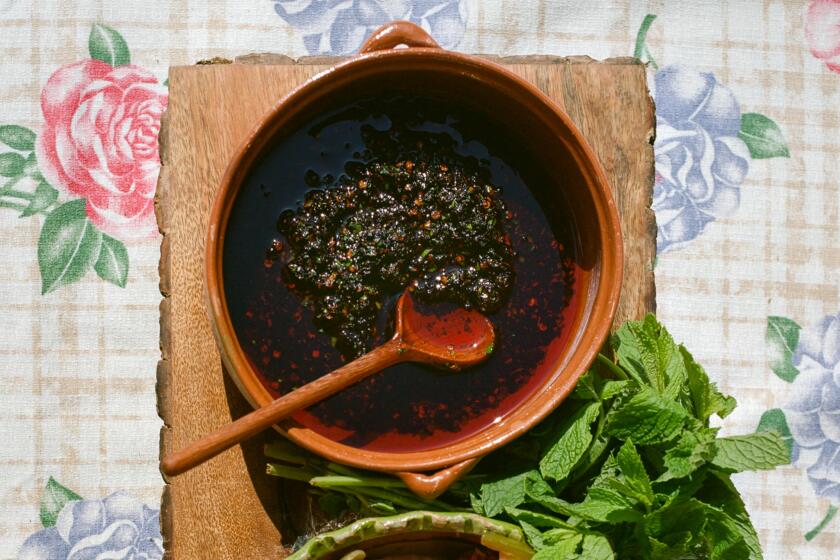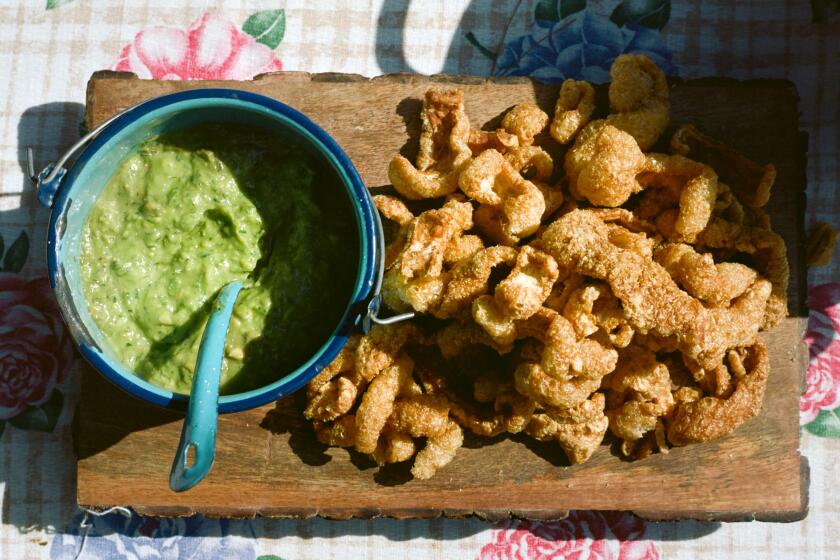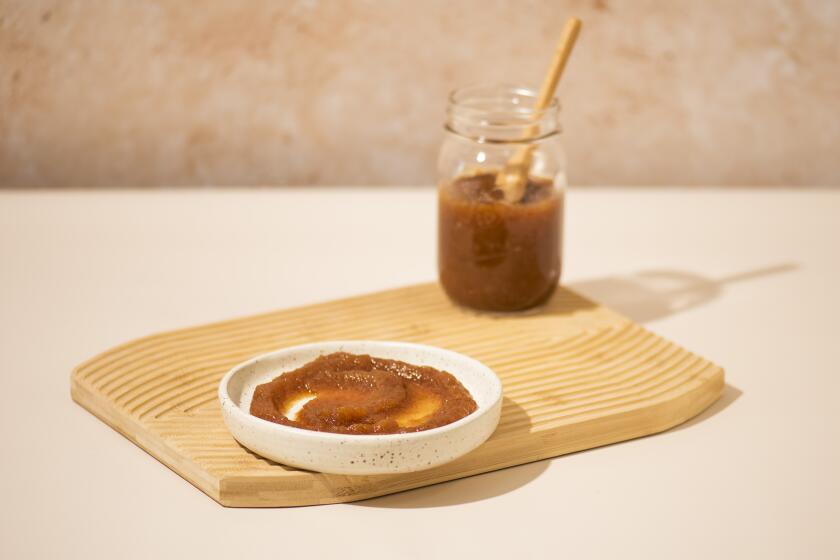Caramel sauce

Of all the caramels in all the world, Richard’s mother had to bring me some from Brittany. Richard is French, and a baker, who jokes that his region is less famous for its bread than its platters of seafood, so poetically called “fruits de mer.” But as I tasted the caramel, I realized that Richard’s hometown had more to commend it than loaves and fishes. It had this stuff. Brittany had caramel.
I have always loved caramel. As a child, I used to stare longingly at plastic-wrapped squares heaped by the checkout counter at our local grocery store. My favorite candy bar is still a Snickers, second favorite a Twix. I never bite into a chocolate from a mixed gift box without checking the key on the lid to see which is caramel.
But as much as I love all these, the tawny little chews in this box from Richard’s mother were different. They were madly intense, super rich and slightly salty. I have never been so powerless in the face of food. Even with one in my mouth, I found that I needed one in my hand. Chewing and holding, I then found it altogether disconcerting to leave the room where the candy box sat on the mantle. Chewing, holding and standing near the mantle, I gave into the compulsion and ate every candy in the box.
That was almost 10 years ago. I did not allow myself near anything like them until the last week, when I got to wondering: What is it about caramel? All caramel, but especially that caramel? What is so compelling about those swelling buttery flavors topped off by toasty-brown notes?
I had to know. There’s nothing like a challenge, particularly when it involves candy.
The investigation begins
My first step was ordering every kind of French caramel that I could find on the Internet and in posh shops around town. Many came in folksy wooden Camembert-style boxes, leading me to expect the Brittany effect. I rolled up my sleeves and started sampling sweeties. They were good, some better than others, but one after another, I could put them down, leave the room, think caramel-free thoughts. They were factory sweets. Nope. Nope, nope, nope.
Second step was calling on the experts. Barry Swanson, a food scientist, more specifically a fabulously informative candy doctor at Washington State University in Pullman, began his primer with a definition of caramelization. Anything with sugar in it can be caramelized, he said. The browning of toast, the golden richness of frying onions, all those wafting good smells that could waken Rip Van Winkle, they are all products of caramelization.
Then there is caramel, the candy. Unsurprisingly, back in 1912, it was a Frenchman, Louis-Camille Maillard, who offered a scientific explanation for caramelization, a process known among chemists as “Maillard browning.” By that time, French confectioners had long mastered the art of cooking a combination of sugar and syrup to a molten sugar state, browning it, creating a myriad of toasty, edgy, even some almost bitter flavors, but stopping just before it burns. They lined tart pans with this sugary glaze, made spun sugar cages, generally worked wonders. Some smart candy maker thought to add sea salt in order to, as Swanson put it, “broadcast” the flavors in our mouths, an artful fillip behind caramel’s lingering richness.
The French also realized that to achieve caramel that makes our mouths water, they needed to add fat and protein to that molten sugar. The best choices of fat, Swanson said, are butter and cream, “that’s what gives you the flavor.” Caramel, it turns out, is not only quintessentially French, it is the sweetest expression of a dairy culture that is so varied, it has a cheese for every day of the year.
As in France, American caramel making took off around dairies. When I phoned Alan Cotich, president of the Classic Caramel Co. in York, Pa., he was keen to emphasize that Milton Hershey started with caramel in the heart of Pennsylvania dairy country before becoming distracted by chocolate. Cotich’s company supplies caramel for big-time candy makers who reformulate it into their products. He sees caramel as a notably honest confection. “No colors or flavors are added to caramel,” Cotich says. “All are developed by proper application of heat and time.”
In other words, if you buy a candy that says it’s got caramel coloring in it, then either a mild caramel has been dyed to suggest a smokier bite than the cooking actually achieved, or it ain’t caramel.
Like Hershey before him, his company grew up in Pennsylvania because of the lush local dairy culture. But they don’t always use cream, Cotich said. Choice of fat is dictated by client. Caramel is so versatile, it can be hard, medium chewy or soft. It goes into suckers, sauce, candy or even as delivery systems for calcium supplements, he said. In each case, there might be a different fat involved: soy oil, coconut oil or refined palm kernel oil.
In Los Angeles, at See’s candies, there are two acceptable fats: whipping cream or butter, usually a mixture of the two. The vice president, Richard van Doren, says of his candies: “They are all natural ingredients.” I never doubted it. What’s more, it’s high time that someone confirmed my long-held belief that See’s Almond Royale is, in fact, a health food.
A swooning success
But it’s still not the sort of caramel that Richard’s mother gave me, something that properly should be a controlled substance. I wondered if I hadn’t somehow imagined their potency. I took to cookbooks, and ran through any number of recipes. I could not find one for salty Breton caramel.
Then my editor remembered some indecently good caramels served in the New York restaurant of French chef Alain Ducasse. To my astonishment, the restaurant agreed to part with the recipe (merci!).
I went out and got the best cream, the best butter and the best sugar I could find. Cheap stuff would not, I was sure, achieve the Brittany effect.
For the next four days, I made Ducasse’s caramels every night and brought them to the office next day. I made them right, I made them wrong. I overcooked them and undercooked them. I made them plain, then with vanilla and maple syrup, then with Valhrona 100% cocoa solids dark chocolate.
I had not misremembered the intensity of fresh French-style caramel. This was the butter, cream and sugar in perfect pitch. I realized why they are so scarce. They are soft, luscious -- halfway to a fresh food. Factory caramels never could taste like these: Butter practically runs from them. The recipe didn’t come with an eat-by date, and we didn’t give any a chance to age, but I’m sure they should be made, served and eaten in fairly good order. They most certainly would become rancid on a candy rack.
Take the trouble to make these, serve them, and they induce rapture. One afternoon, I passed out the caramels in the newsroom. Of approximately 100 people offered them, only two declined. The most typical reactions were a cry to the heavens, purrs, groans, astonishment at the richness and waves of complex flavors.
When one colleague registered the flavors, he practically shouted, “Sweet Mary mother of God!”
To those who have yet to try these, please don’t take offense. It’s not sacrilege. That’s the Brittany effect. That’s caramel.
Combine the sugar with the water and a squeeze of lemon juice in a heavy saucepan. Stir to combine and cook over low heat until the sugar dissolves, 3 to 4 minutes. (The lemon juice helps stop the sugar from crystallizing.) Increase the heat to medium and boil the syrup rapidly without stirring until it starts to turn golden around the edges, about 10 minutes. Do not stir -- if you do, the syrup may crystallize.
Meanwhile, melt the butter with the cream in a separate saucepan over medium heat.
When the syrup begins to color, lower the heat a bit and continue boiling to a deep golden color, about 3 to 4 minutes; it will darken rapidly. Remove the pan from the heat and let it cool for 30 seconds. Add the butter mixture, standing back as the sauce will sputter and bubble up in the pan. Put it back over the heat, stirring until the caramel is completely dissolved. Let the sauce cool, then taste it and add a dash of salt to sharpen the flavor. Serve hot or chilled.
Get our Cooking newsletter.
Your roundup of inspiring recipes and kitchen tricks.
You may occasionally receive promotional content from the Los Angeles Times.









